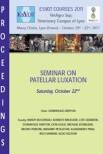BACKGROUND: Lameness can be multifactorial and may result from the accumulation of multiple seemingly unrelated causes. The identification of factors associated with lameness could be one method to decrease incidence of lameness and prolong the equine athlete's competitive life.
OBJECTIVES: To determine if there is an association between hoof balance in the sagittal plane and hindlimb lameness.
STUDY DESIGN: Case-control study.
METHODS: Eighty client-owned horses with hindlimb lameness (cases) and 80 horses with no detectable hindlimb lameness (controls) were prospectively enrolled following lameness evaluation as either cases (lameness localised with regional anaesthesia) or controls (no hindlimb lameness). Lameness cases were divided based on location (stifle, tarsus, proximal metatarsus, and other sites). Lateromedial radiographs were performed of hind hooves and plantar angle of the distal phalanx (PADP) was determined. The prevalence of negative/neutral PADP and median PADPs were calculated. Conditional logistic regression and Wilcoxon signed rank tests were used to analyse PADPs, and odds ratios were calculated. Significance was set at P<0.05.
RESULTS: The mean PADP was significantly smaller in cases compared to controls. The mean PADP was significantly smaller in horses with lameness localised to tarsus and proximal suspensory, but not the stifle. Lameness in horses was associated with a negative/neutral PADP (Odds ratio [OR] 3.87, 95% confidence interval [95%CI] 1.97-7.61, p<0.01), with lameness localised to the tarsus (OR 4.98, 95%CI 1.34-18.54, p = 0.01) and proximal suspensory (OR 5.16, 95%CI 1.11-23.89, p = 0.03) being associated with a negative/neutral PADP.
MAIN LIMITATIONS: It is unknown whether the negative/neutral PADP contributed to lameness or lameness resulted in lower PADP.
CONCLUSIONS: Horses with hindlimb lameness localised to the distal tarsus and proximal metatarsus, but not the stifle, were more likely to have negative/neutral PADPs. Corrective farriery to improve PADP may be investigated further as one component in the treatment of hindlimb lameness localised to regions proximal to the foot.









